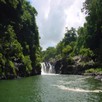Quick Facts: Eastern Mauritius
- Eastern Mauritius is home to the longest and largest lagoon on the island
- Eastern Mauritius experiences the south-east trade winds throughout the year
- The area is best visited in summer as winter can be relatively cold and windy
- A variety of off-shore islands dot the sea off the eastern coastline
- Eastern Mauritius is relatively undeveloped when compared to the north-west areas
Introducing Eastern Mauritius
Left wild for many years, the east-coast of Mauritius has seen a great influx in tourism developments in the last 10 years. The east-coast of Mauritius features the longest lagoon on the island which is flanked by picturesque mountains. The area is best visited in the summer months and the trade winds prevail throughout winter which can be cold and rainy. The area is also home to some off-shore islands that can be easily reached via boat excursions.
This region is still relatively undeveloped when compared with the northern and western coastlines of Mauritius and provides the ideal place for a secluded, romantic holiday on long stretches of un-touched beaches. Some of the best beaches on the island can be found here and they are flanked by long stretches of sugar cane plantations and palm trees.
Major places of interest
Ile aux Cerfs is found on the eastern coast of Mauritius. This islet is a magnificent spot for photographs and a magnificent golf course can be found here. This place of rare beauty is best visited via a boat excursion. The longest river in Mauritius, the Grande Riviere Sud Est can be accessed via boat excursions up the river mouth. The banks of the river are flanked with wild and rich vegetation.
The Trou d'eau Douce fisherman’s village is a rural town where one can get the true feeling of Mauritius. Roches Noires is a residential area that consists of a series of peculiar coves which present secluded and private beaches for visitors to enjoy. Flacq is the largest village on the east-coast and is home to the largest open air market in Mauritius.
People
The eastern coastal communities are isolated to the small villages and the industry relies primarily on fishing and farming. Pockets of poverty can be found on the eastern coastline and the levels of education are lower than those locals living in central Mauritius.
Topography and climate
The east coast of Mauritius experiences the south-east trade winds throughout most of the year. The area is relatively windy especially during the winter months between June and September. During these winter months the evenings can be very cold.
Mauritius’ largest and longest lagoon lies of the east coast and stretches for roughly 22 kilometers. The shallow lagoon is permeated with deep canals, creating a picturesque turquoise and deep green sea. The lagoon areas are flanked by towering mountains, making this region one of the most picturesque spots on the island.

.jpg)


.jpg)

.jpg)


.jpg)
